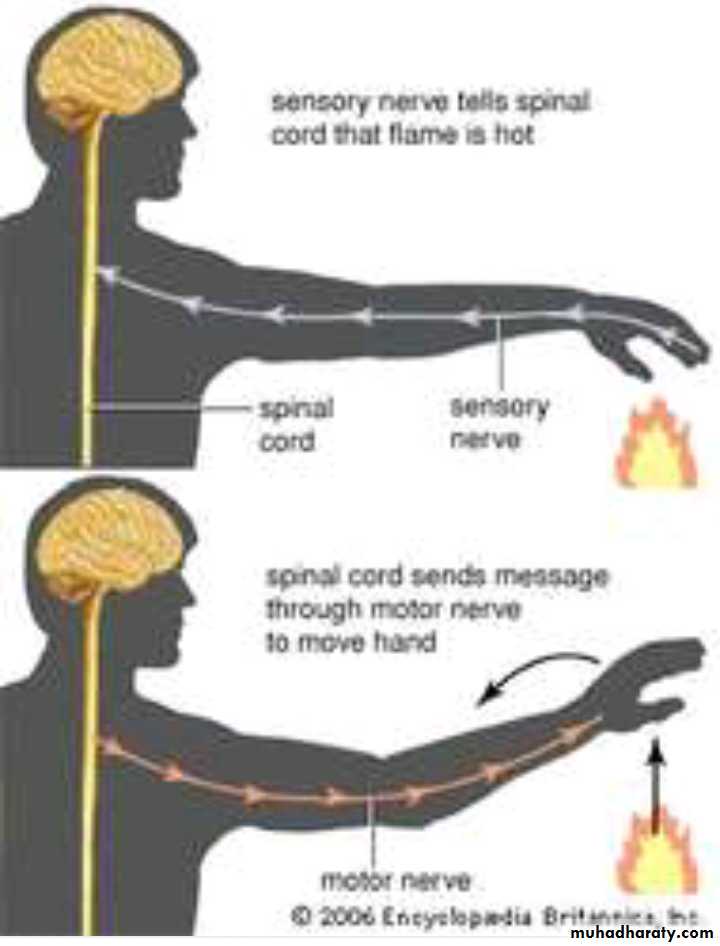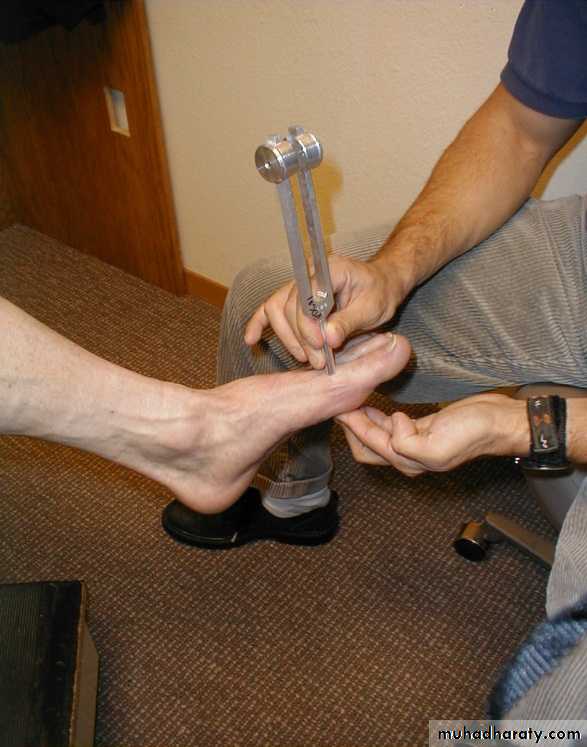Thermal Sensations
The human being can perceive different gradations of cold and heat, from freezing cold to cool to indifferent to warm to hot to burning hot.
Receptors:
we have cold receptors, warmth receptors, and pain receptors.The pain receptors are stimulated only by extreme degrees of heat or cold “freezing cold” and “burning hot” sensations.
The cold and warmth receptors are located immediately under the skin at separated spots. Inmost areas of the body, we have 3 to 10 times cold than warmth receptors.
They are free nerve endings .
warmth signals are transmitted mainly over type C nerve fibers.
cold transmitted by small type A-delta myelinated nerve ending.Nerve fibers that transmit the sensation:
(1) pain fiber stimulated by cold,(2) cold fiber,
(3) warmth fiber, and
(4) pain fiber stimulated by heat.
--In the very cold region, only the cold-pain fibers are stimulated. As the temperature rises to +10° to 15°C, the cold-pain impulses cease,
-- The cold receptors begin to be stimulated, reaching peak stimulation at about 24°C and fading out slightly above 40°C.
--Above about 30°C, the warmth receptors begin to be stimulated, & fade out at about 49°C.
-- Finally, at around 45°C, the heat-pain fibers begin to be stimulated by heat.
Adaptation of Thermal Receptors
The thermal receptor “adapts” to a great extent. When a cold receptor is suddenly subjected to an sudden fall in temperature, it becomes strongly stimulated at first then fades rapidly during the first few seconds and more slowly during the next 30 minutesThis means that when the temperature of the skin is actively falling, a person feels much colder than when the temperature remains cold at the same level. Conversely, if the temperature is actively rising, the person feels much warmer than if were constant.
Transmission of Thermal Signals in the Nervous System
In general, thermal signals are transmitted in pathways parallel to those for pain signals. On entering the spinal cord, the signals transmitted by anterolateral sensory tract and terminate in both• the reticular areas of the brain stem and
• the sensory nucleus of the thalamus.
A few thermal signals are also relayed to the cerebralsomatic sensory cortex.
The mechanoreceptive somatic senses
Which include both the tactile senses (touch, pressure, vibration, and tickle ) and the position senses(include static position and rate of movement senses).Tactile Sensations
That includes touch, pressure, vibration, and tickle senses
They are detected by the same types of receptors(mechanoreceptors)
There are three principal differences among them:
(1) touch sensation generally results from stimulation of tactile receptors in the skin
(2) pressure sensation generally results from applying force to an area of skin that cause deformation of deeper tissues
(3) vibration sensation results from rapidly repetitive sensory signals
Tactile Receptors:
There are at least six entirely different types of tactile receptors; their special characteristics are the following:1-free nerve endings, which are found everywhere in the skin transmit signals mainly by way of the small type A d myelinated fibers, can detect touch , pressure, tickle , itching, temperature and pain.
2- Meissner’s corpuscle a touch receptor with great sensitivity is the nerve ending of a large (type Ab) myelinated fiber.
they are present in the non hairy parts of the skin and are particularly in the fingertips and lips .Adapt in a fraction of a second
3- Merkel’s discs, in the fingertips and the hairy parts of the skin. These receptors partially adapting (transmit an initially strong signal and then a continuing weaker signal). that allow one to determine continuous touch of objects against the skin
Also they innervated by a large myelinated nerve fiber (type Ab).
4- hair end-organ hair and its basal nerve fiber, slight movement of any hair on the body stimulates a nerve fiber in its base.
5- Ruffini’s end-organs located in the deeper layers of the skin. These endings adapt very slowly and, therefore, are important for signaling continuous states of deformation of the tissues. They are also found in joint capsules
6- pacinian corpuscles, lie both immediately beneath the skin and deep in the fascial tissues of the body. They adapt rapidly
Two-Point Discrimination
Two-point discrimination is a widely used technique for assessing tactile perception
In this test, two needles are pressed lightly against the skin at the same time, and the person determines whether two points of stimulus are felt or one point.On the tips of the fingers, a person can distinguish two separate points even when the needles are as close together as1 - 2 millimeters. However, on the person’s back, the needles must usually be as far apart as 30 – 70millimeters before two separate points can be detected. The reason for this difference is the different numbers of receptors in the two areas and lateral inhibition
Vibratory Sensation
Vibratory signals are rapidly repetitive sensory signalsAll tactile receptors are involved in detection of vibration.
These signals are transmitted only in the dorsal column pathway.
For this reason, application of vibration (from a “tuningfork”) to different peripheral parts of the body is an important tool used by neurologists for testing functional integrity of the dorsal columns.
Position Senses
The position senses are frequently also called proprioceptive senses. Proprioception means "sense of self". In the limbs, the proprioceptors are sensors that provide information about joint angle, muscle length, and muscle tension, which is integrated to give information about the position of the limb in spacePosition senses can be divided into two subtypes:
• static position sense
• dynamic proprioception
Position Sense Information transmited in the Dorsal Column–Medial Lemniscal Pathway
Receptors:
multiple different types of receptors help to determine joint angulation and position sense. Both skin tactile receptors and deep receptors near the joints are used.In the case of the fingers, where skin receptors are in great abundance, position recognition is mainly detected through the skin receptors. Conversely, for most of the larger joints of the body, deep receptors are more important
The muscle spindle is proprioceptor that provides information about changes in muscle length.
The Golgi tendon organ is proprioceptor that provides information about changes in muscle tension.
Types of sensory endings used for this are the pacinian corpuscles, Ruffini’s endings.
The pacinian corpuscles and muscle spindles are the receptors most responsible for detecting rate of movement.
TICKLE AND ITCH
Receptor: rapidly adapting mechanoreceptive free nerve endings in superficial layers of the skin that elicit only the tickle and itch sensations. These sensations are transmitted by small type C, unmyelinated fibersThe purpose of the itch sensation is to call attention to mild surface stimuli such as a flea crawling on the skin or a fly about to bite, and the elicited signals then activate the scratch reflex that rid the host of the irritant.
Transmitted in the anterolateral system



